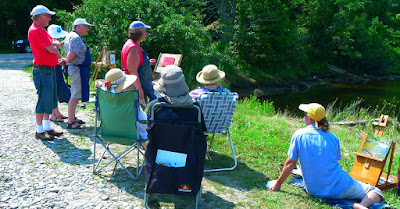What’s shifting in 2017 holiday marketing? A lot, especially with email.
 |
|
Off Marshall Point, by Carol L. Douglas. This is for sale in Chrissy Pahucki’s new venture, pleinair.store.
|
If you sell paintings, you’re in retailing. And if you’re in retailing, you’ve probably learned by now that holiday sales are an important part of your business. While all retailing sees a jump during the holiday selling spree, the jewelry sector posts more than a quarter of its annual sales during the holidays. That’s important because jewelry sales and painting sales have much in common. They’re both luxury items, and their value is primarily aesthetic.
For a decade, seasonal spending outpaced the US economy, meaning we were concentrating our money more in that one-month period. Then, in 2016, something changed. Seasonal sales were down, except for automobiles and gasoline.
One year does not a trendline make, but I’ve noticed a few things this year. The absurd deals that created Black Friday culture weren’t in my Thanksgiving newspaper (which cost $4, by the way). Retailing is in a major meltdown right now, with bricks-and-mortar stores closing in the face of new consumer trends.
 |
|
Tilt-a-Whirl, by Carol L. Douglas. This is for sale in Chrissy Pahucki’s new venture, pleinair.store.
|
But the thing that really hit home was the abuse of my in-box over the past week. I’ve been deleting a few hundred email ads a day without even opening them. I receive multiple, similar offers from the same vendors. They’re all companies I like and have purchased from, but they’ve created a wall between me and the emails I need to see. In other words, they’ve tipped email into a black hole as a marketing strategy.
How does an artist make his or her voice heard in that cacophony? The short answer is, we can’t. I’m only looking at mail from my close friends and business associates right now, so if you sent me a seasonal special offer, it was deleted without opening.
 |
|
Glen Cove Surf, by Carol L. Douglas. This is for sale in Chrissy Pahucki’s new venture, pleinair.store.
|
Artists must watch retailing trends carefully. It’s not enough to understand what others are doing now, we have to understand what others plan to do. I watched a webinar recently about creating an email marketing funnel. This is an advertising concept that converts brand awareness to sales. Like every other one-person shop, I could be a lot better at it.
The presenter taught us how to collect email addresses and then qualify and refine information about the buyer. That was fine, but it ignores a basic reality: people sent and received 269 billion emails per day in 2017. With all that chatter—and it’s so much cheaper than snail mail—it’s almost impossible for your message to stand out with any clarity.
 |
|
Marginal Way, by Carol L. Douglas. This is for sale in Chrissy Pahucki’s new venture, pleinair.store.
|
In the end, on-line sales will have created new and different problems from the ones they seemed to fix. As always, the muscle will lie with the big marketers that have the time and talent to tinker with new strategies, not with sole proprietors like us.
What’s a poor artist to do? First, realize we’re not alone in this. Every small retailer faces the same problem. From my vantage point, we do the same things we’ve always done: reach out to regular customers, create opportunities to buy, and carefully analyze the competition’s marketing strategy. Above all, we have to be open to new ideas, which is why I’m trying out Chrissy Pahucki’s new venture, pleinair.store.
And somehow, we need to find time to paint.













